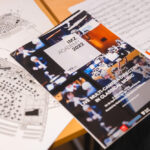This past April, the SSO’s Simeon Taylor and Mark Turner had the chance to experience a world first.
The duo co-direct the live streaming of the SSO’s performances and are the creative team behind ConcertStream.tv – together they’ve filmed dozens of performances for live streaming and video-on-demand. Pairing Taylor’s background in film and Turner’s background in music, the two work in tandem to direct and capture a live performance that helps you see what they want you to hear.
 When they started live streaming in fall of 2020, they didn’t dream that they’d end up flying to Sweden to experience the first ever gathering of directors of orchestral streaming…but in April they boarded a plane bound for Gothenburg and found themselves spending a week with peers from around the globe gathered together to explore the world of multi-camera orchestral filming.
When they started live streaming in fall of 2020, they didn’t dream that they’d end up flying to Sweden to experience the first ever gathering of directors of orchestral streaming…but in April they boarded a plane bound for Gothenburg and found themselves spending a week with peers from around the globe gathered together to explore the world of multi-camera orchestral filming.
Helmed by the IMZ International Music + Media Centre, the week was lead by renowned directors Peter Maniura and Kriss Russman, with Mons Per Fogelberg (head of streaming for the Gothenburg Symphony Orchestra) and the GSO’s entire streaming team. After days spent learning from the best, Taylor and Turner got to sit in the director’s seat and film a performance by superstar soprano Barbara Hannigan. A thrill to film this exceptional Canadian artist alongside the Gothenburg Symphony, the week lead to incredible opportunities to learn from the best, connect with colleagues around the globe, and be part of the creation of a network that allows for the filming of orchestral performances to grow and flourish!
The SSO is grateful to the support of SKArts for supporting Simeon Taylor’s participation in the IMZ Academy.



 I’m proud of what we’ve accomplished as an organization over the years and how we’ve been an innovative force in the Canadian music scene. Some highlights have been the many Saskatchewan and Canadian musicians and music we’ve featured, our growing presence in the community, and simply daring to try new things and making them work. Part of this is creative momentum and I strongly believe new ideas and fresh perspectives are paramount to artistic growth. That’s why I’m very excited in passing the torch to new musical leaders and seeing how they contribute to the future of the SSO.
I’m proud of what we’ve accomplished as an organization over the years and how we’ve been an innovative force in the Canadian music scene. Some highlights have been the many Saskatchewan and Canadian musicians and music we’ve featured, our growing presence in the community, and simply daring to try new things and making them work. Part of this is creative momentum and I strongly believe new ideas and fresh perspectives are paramount to artistic growth. That’s why I’m very excited in passing the torch to new musical leaders and seeing how they contribute to the future of the SSO.

 For his eighth and latest Deutsche Grammophon album, Canadian pianist extraordinaire Jan Lisiecki has chosen to return to the music of Frédéric Chopin. Following on from Works for Piano & Orchestra (2017) and Chopin: Études (2013), Chopin: Complete Nocturnes features profoundly personal interpretations of some of the most beautiful and best-loved pieces ever written for solo piano.
For his eighth and latest Deutsche Grammophon album, Canadian pianist extraordinaire Jan Lisiecki has chosen to return to the music of Frédéric Chopin. Following on from Works for Piano & Orchestra (2017) and Chopin: Études (2013), Chopin: Complete Nocturnes features profoundly personal interpretations of some of the most beautiful and best-loved pieces ever written for solo piano.